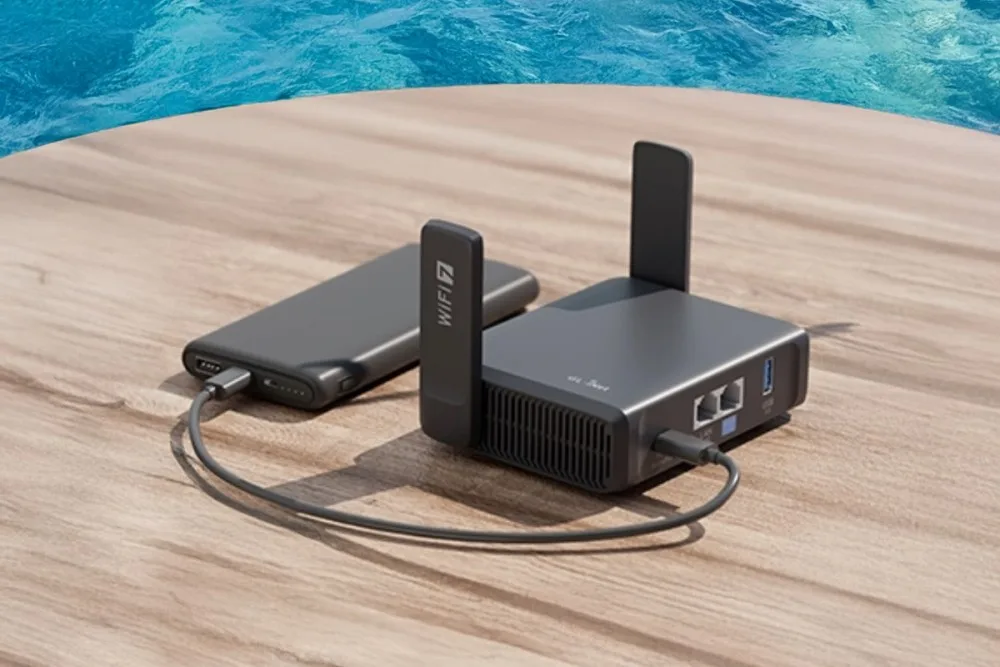Few travel conveniences match the comfort of always-on, secure, high-speed internet. Whether you’re a frequent flyer, weekend explorer, or remote worker drifting from coffee shops to conference centers, reliable Wi-Fi is vital. Yet, public networks are often slow, overloaded, or riddled with restrictive portals.
That’s where a portable travel router swoops in to save your data and sanity. In this guide, I’ll walk you through what travel routers do, which features matter most in 2025, the top models worth your time, and a new device on the horizon you’ll want to keep an eye on.
I’ve personally tested and researched numerous travel routers over the past few years—some are super compact and straightforward, others are brimming with advanced features.
From ensuring your streaming device can link to a hotel TV, to running an always-on VPN for secure data, a portable router can transform your travel experience. So let’s dive right in and explore how these devices can keep you comfortably connected, no matter where your journey takes you.
Why a Travel Router Matters More Than Ever in 2025
Free Wi-Fi is nearly everywhere—airports, coffee shops, hotels, even entire neighborhoods. But these networks often introduce frustrations: captive portal logins for each device, limited bandwidth, or suspicious data security.
That’s when a travel router becomes your favorite companion. Let’s look at the main reasons you might want to stash one in your backpack or suitcase.
1. Simplified Connections for Multiple Devices
Travel with a laptop, phone, tablet, plus a streaming stick? Instead of logging each device into the hotel’s captive portal or paying a per-device fee, you simply connect your portable router once.
Then your devices link to it automatically. No re-logging or dealing with complicated disclaimers. This eliminates hassle if, say, you have six devices but the hotel only allows you two logins. Your router is recognized as one device, bridging your entire personal network behind it.
2. Enhanced Security on Public Wi-Fi
The biggest perk of a personal router is controlling your data flow. Instead of hooking each gadget to a questionable hotspot, you only expose the router to that network. If your travel router supports VPN, you can enable encryption so everything from your laptop to your phone tunnels securely.
Hackers snooping on that open café Wi-Fi are far less likely to intercept your traffic because all they see is encrypted data from your router. Peace of mind is a big plus, especially for business travelers handling sensitive files or logins.
3. Casting and Streaming Without Headaches
Hotels and hostels sometimes block device-to-device communication, making it impossible to cast from your phone to a Chromecast or a Fire Stick connected to the room’s TV.
By bridging everything through your personal router, your devices see each other locally. You can watch your favorite shows, continue binge sessions, or mirror your phone’s screen with ease—no wrangling the hotel’s restrictive network settings.
4. Consistent Login and SSID
Imagine how nice it is when your phone and tablet automatically reconnect to the same SSID and password you use at home. That’s exactly what a travel router offers. You configure your network name and password once, and wherever you go, your devices treat it like “home Wi-Fi.”
Meanwhile, the router itself deals with external networks in the background. No more typing random codes or scanning weird QR sheets each time you move to a new hotspot.
5. Failover and Multi-WAN Options
Higher-end travel routers let you combine or switch between multiple internet sources. Maybe you have an Ethernet cable from the hotel, but you also tether your phone as a backup.
If the wired line drops, your router automatically flips to cellular data, so your Zoom calls or cloud uploads remain uninterrupted. If you rely on stable internet for remote work, having failover is a lifesaver when traveling in areas with unpredictable coverage.
Key Features That Matter Most
So you’ve decided a portable router makes sense. But how do you pick one in a sea of brands and models, each touting different speeds and buzzwords? Here’s a breakdown of must-haves I think are vital for a 2025 purchase:
1. Wi-Fi 6 or Solid Dual-Band Speeds
Gone are the days when single-band 2.4 GHz was enough. Modern travelers often juggle multiple streaming or real-time apps. Wi-Fi 6 (also called 802.11ax) dramatically increases efficiency, letting you connect more devices without slowdown.
Even if you opt for a dual-band AC1200 or AX1800 router, the bandwidth boost over older single-band N300 devices is substantial. If you plan on streaming 4K content or gaming in hotels, Wi-Fi 6 can handle heavy usage more smoothly.
Additionally, dual-band ensures you can switch to 5 GHz in hotels crammed with 2.4 GHz signals. Or you can stick to 2.4 GHz if you need better wall penetration. It’s all about versatility in tricky environments.
2. VPN Integration
Privacy is a top reason travelers keep a router on hand. Many travel routers these days run on custom firmware (like OpenWrt) and support multiple VPN protocols out of the box. By enabling your favorite VPN inside the router’s control panel, you no longer have to run separate VPN apps on each phone or laptop.
Everything behind the router is auto-encrypted. This approach also helps in regions with heavy internet censorship or content geoblocking, though of course laws vary by country.
3. Various WAN Input Methods
Hotel Wi-Fi is one approach, but what if the place has a decent wired port? Some of the best portable routers have an Ethernet WAN input so you can skip the often-unreliable hotel wireless altogether.
Tethering your phone’s data is another popular fallback, especially if the local network is abysmal. The more WAN options your router supports, the more confident you’ll be about staying online regardless of your environment.
4. USB Power or Built-In Battery
A router that can be powered by standard USB Type-C is brilliant. Forget carrying a special barrel plug or heavy adapter. You can just plug it into the same power bank used for your phone. Some higher-end models even have internal batteries, ensuring they keep running if your environment has flaky power or if you’re briefly disconnected from an outlet. That said, built-in batteries add weight, so weigh the trade-off.
5. Storage Ports
If you want to share photos, documents, or media while traveling, a USB port or microSD slot turns your router into a mini file-sharing hub. This is handy for group trips: friends or coworkers can access a shared drive locally, off the internet. Keep in mind that performance speeds vary, but it’s often enough for streaming stored videos or pulling large files from a USB drive while on the move.
Deep Dive: Top Travel Routers for 2025
Below, I’ll highlight my favorite models, drawing from extended usage, input from other travelers, and hours of reading user forums. Each router has a unique flavor—some excel at raw speed, others at budget-friendly utility. Let’s see which one best fits your style.
1. GL-iNet Slate AX (AXT1800)

Why It Stands Out: The Slate AX is widely praised for merging compact design with Wi-Fi 6 power. It hits around 600 Mbps on 2.4 GHz and up to 1200 Mbps on 5 GHz, thanks to an AX1800 rating. That’s usually more than enough for everyday streaming, gaming, or remote work.
Additionally, it runs on a flavor of OpenWrt, so you can configure advanced features like VPN, domain-based ad-blocking, or guest networks. There are three Gigabit Ethernet ports, letting you handle wired connections if the local Wi-Fi is terrible, or wire in additional devices if you’re setting up a mini-office in a hotel suite.
VPN Performance & Tethering: Slate AX integrates well with major VPN providers. You can upload your config file for OpenVPN or WireGuard in just a few steps. The CPU is powerful enough to handle encryption at a decent rate.
If you want to tether your phone, just plug it into the router’s USB port. This works well when 4G or 5G signals are more reliable than the local Wi-Fi. Another plus is that the antennas fold, minimizing the chance of breakage in your bag.
Ideal For: Someone who needs robust Wi-Fi 6 speeds in a portable device. If you regularly do heavier tasks—like streaming multiple HD videos or running large file transfers for work—the Slate AX can keep up. The only downside is the cost: it’s pricier than simpler AC1200 routers. But if you want top-tier performance, you’ll love it.
2. GL-iNet Barrel AX (GL-MT3000)
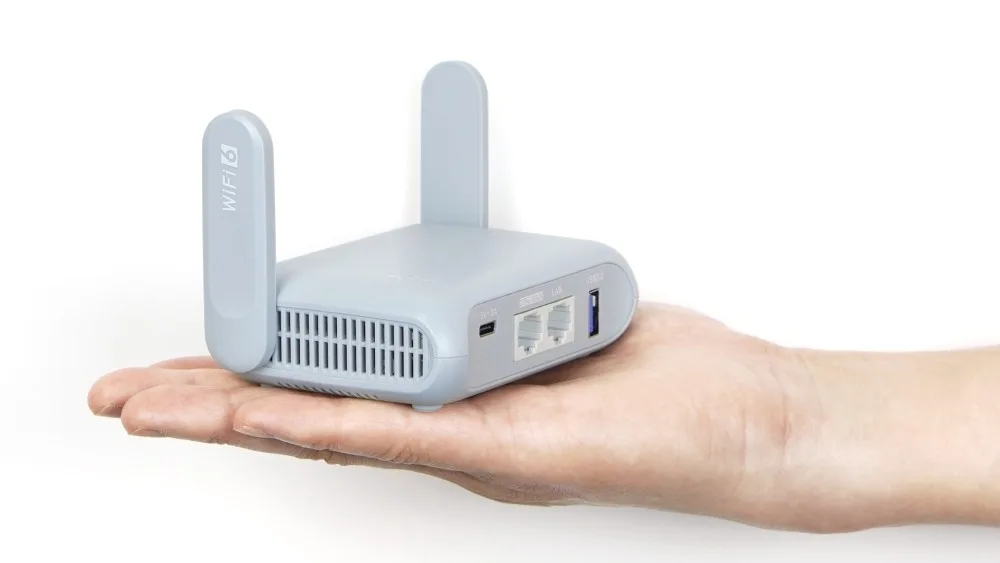
Why It Stands Out: The Barrel AX is a travel router that includes two 2.5 Gbps Ethernet ports—extremely rare in such a small device. If you stumble upon ultra-fast WAN or you like hooking up a NAS or other gear at high speeds, this is a dream come true.
It’s also a Wi-Fi 6 router, so you’re looking at robust coverage and stable multi-device performance. Like the Slate AX, it uses an OpenWrt-based OS, so advanced routing options, VPN setups, and extra plugins are just a few clicks away.
VPN Muscle: The Barrel AX’s processor is geared to handle encryption tasks well, meaning less speed drop when you activate WireGuard or OpenVPN. That’s a boon for travelers who want privacy without a significant performance hit.
Tethering works nicely too, so if the local connection is subpar, connect your phone to keep the entire network online. The device can run off USB Type-C, which is convenient for consistent power from a laptop or a single universal charger.
Ideal For: People who want maximum speed in a compact footprint, especially if they plan to connect multiple high-bandwidth devices. It’s a bit bigger and pricier than budget models, but the payoff is top-end performance, fast encryption, and flexible 2.5 Gbps ports. If you’re a “power user” traveler, the Barrel AX is mighty attractive.
3. GL-iNet Mango (GL-MT300N)
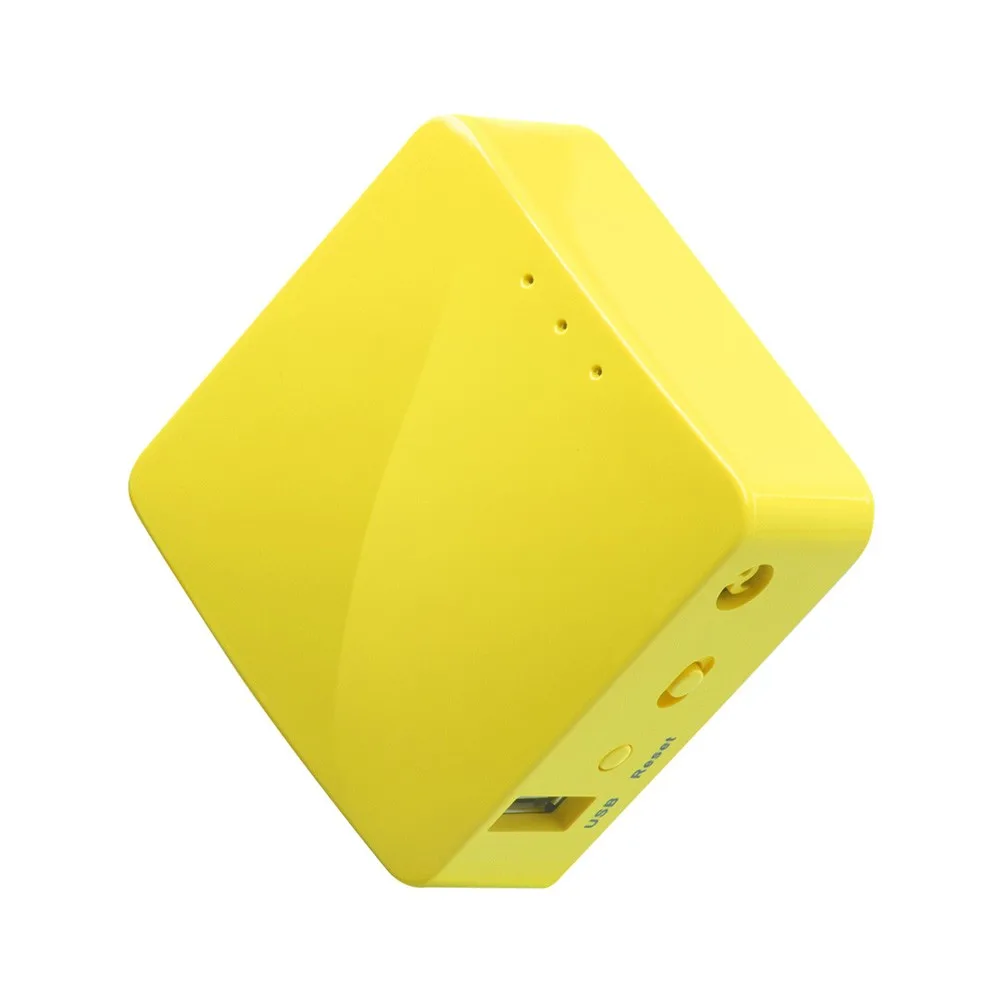
Why It Stands Out: The Mango is more about simplicity and low cost. It only offers single-band 2.4 GHz Wi-Fi with up to 300 Mbps theoretical speeds, and 100 Mbps Ethernet. On paper, that’s nothing fancy. But in practice, it’s enough if all you want is a straightforward router to unify your devices behind a single SSID.
It remains one of the cheapest ways to get VPN support on the go, thanks to its trimmed-down OpenWrt firmware. You can also tether a phone or connect to a public hotspot in repeater mode. It’s unbelievably small—smaller than many battery banks—and weighs next to nothing.
Limits and Use Cases: Because it’s 2.4 GHz only, it can be slow in crowded areas. If you’re in a busy hotel or convention center, you might see speed dips. Still, travelers love how easy it is to toss this in a pocket and forget about it until they need it.
Setting up a VPN is possible (WireGuard or OpenVPN), though not at blazing speeds. The Mango is perfect for checking email, messaging, or moderate streaming, but not for heavy 4K Netflix or multi-user loads. The price, though, is its biggest advantage.
Ideal For: Budget-minded travelers who just need basic sharing. If you have a complicated setup with many devices or you rely on fast streaming, you might want a dual-band or Wi-Fi 6 alternative. But for minimal everyday usage, this is a gem.
4. GL-iNet Opal (GL-SFT1200)
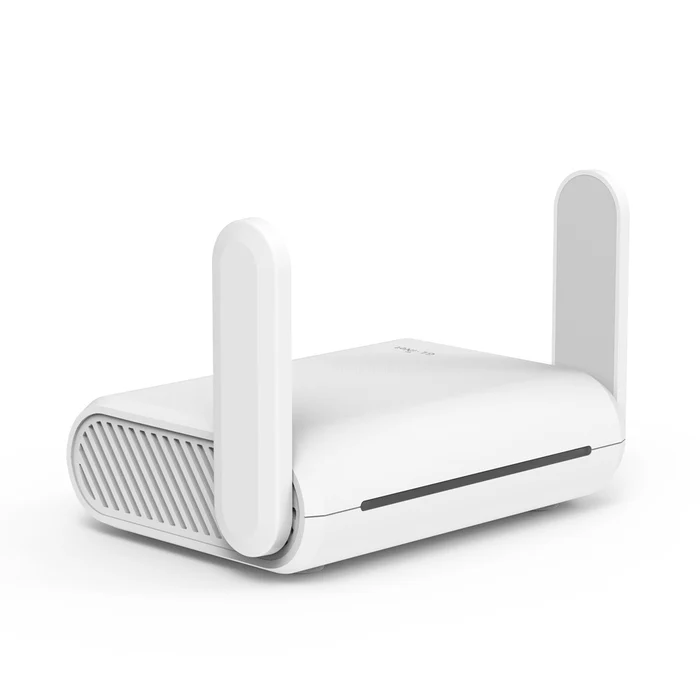
Why It Stands Out: If you want something a step up from single-band but aren’t quite ready to go Wi-Fi 6, the Opal is a perfect middle ground. It’s a dual-band AC1200 travel router with 3 x Gigabit Ethernet ports and a USB Type-C power input.
Like others from GL-iNet, it supports VPN, tethering, and local file sharing. The dual-band speeds (up to around 867 Mbps on 5 GHz and 300 on 2.4 GHz) are more than sufficient for Netflix or YouTube streaming for a few devices simultaneously.
Practical Uses: The Opal is often recommended for short-term rentals or business travelers who want a steady, mid-range router. Setup is straightforward via the built-in interface. It’s physically small enough to fit in your backpack easily, and power over USB Type-C means you probably have a compatible power brick on you anyway.
It’s not as advanced as the Wi-Fi 6 line, but for those who don’t need cutting-edge speeds, it’s a sweet spot of affordability and performance.
Ideal For: Travelers who prefer a bit of extra speed over single-band but don’t want to pay a premium for Wi-Fi 6. If you regularly do moderate HD streaming and want a stable dual-band connection, the Opal fits nicely.
5. TP-Link AX1500
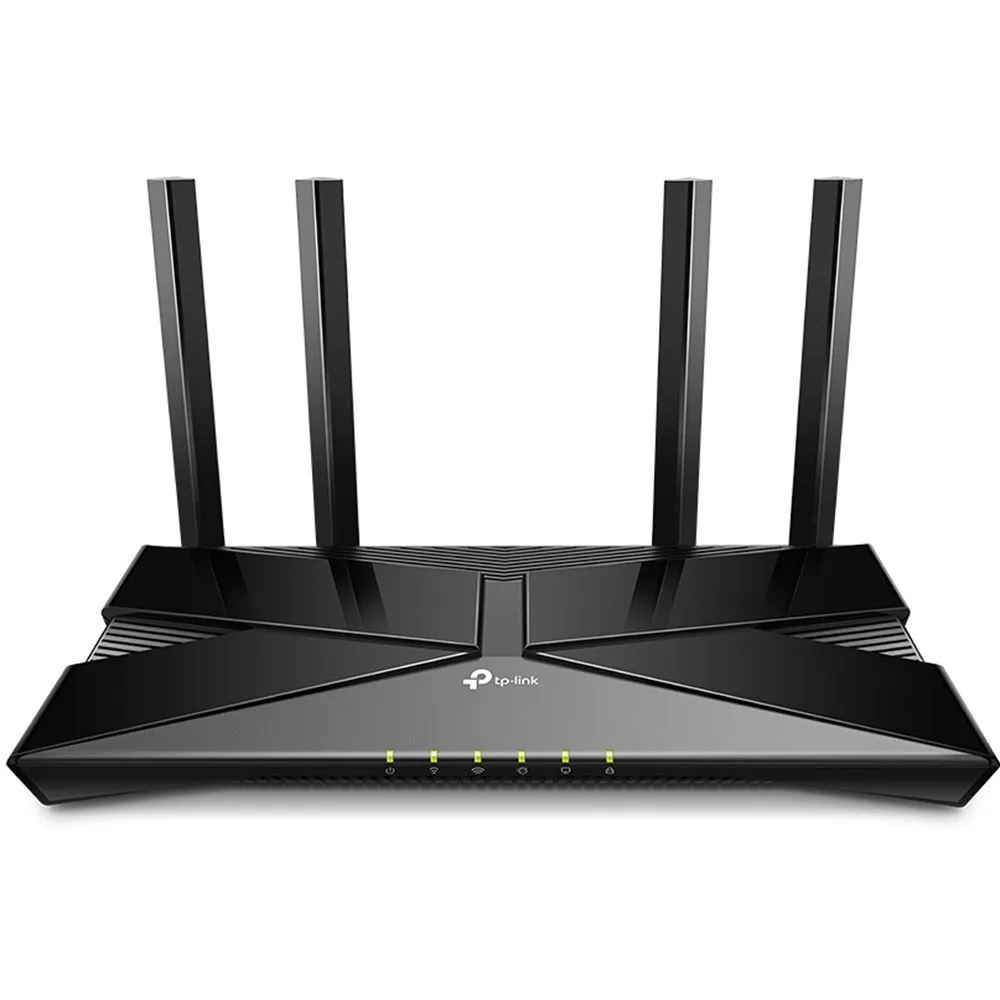
Why It Stands Out: If brand familiarity is important, TP-Link’s AX1500 is a user-friendly Wi-Fi 6 router with up to 1500 Mbps total throughput. It has two Gigabit Ethernet ports, a USB-C power port, and internal antennas for a sleeker travel footprint.
You can use a smartphone app to set it up, which might be less intimidating for novices compared to an OpenWrt-based interface. There’s also a captive portal wizard that helps you log in quickly at hotels.
Performance & Simplicity: While it might not offer the advanced customizations some others do—like integrated ad-blocking or advanced VPN toggles—the AX1500 is still fairly robust. If you’re streaming or doing teleconferences, Wi-Fi 6 keeps speeds steady even with multiple devices connected.
For travelers who want a well-known brand name and straightforward operation, the AX1500 is worth a look. Just note that if you need or want deeper network tinkering, it may not match the open-source routes from GL-iNet or comparable brands.
Ideal For: Anyone looking for a standard Wi-Fi 6 experience without diving into heavily customized firmware. It’s a comfortable entry point to portable routers if you prefer simpler, more mainstream controls.
6. Simo Solis 4G LTE Hotspot
Why It Stands Out: This is less of a travel “router” in the traditional sense and more of a battery-powered personal hotspot that doesn’t require you to track down local SIM cards. For travelers who want to dodge questionable hotel networks altogether, Simo’s Solis can be a game-changer.
It typically provides 4G LTE in many regions, with data plans sold by the company, so you can connect up to ten devices on the go. People love that convenience, especially if they jump from one country to another quickly without messing with local carriers.
Trade-Offs: You won’t get the same advanced router features (like multi-WAN or direct VPN integration). The speeds, while decent, aren’t going to match your home cable or fiber. But for casual travelers needing basic coverage everywhere, it can be a major relief. The internal battery also ensures it’s fully portable, no cords needed for some hours at a time.
Ideal For: Folks who want universal connectivity without wrestling with each public hotspot. Families on vacation often prefer it so they can skip captive portals entirely, though you need to watch out for data plan costs if you stream heavily.
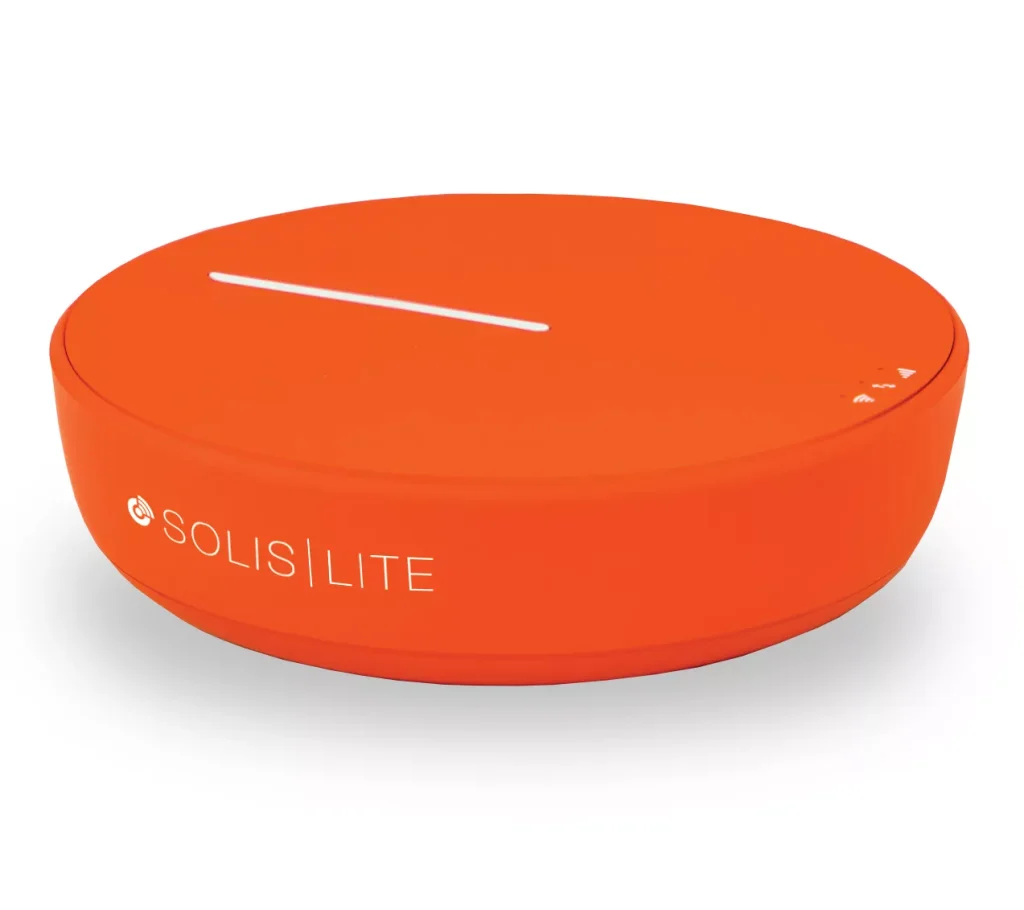
Real-World Travel Scenarios
Let’s see how these routers might fit into typical journeys or use cases. Sure, the specs look impressive, but day-to-day usage reveals which features truly matter.
Scenario 1: Hotel Room with a Chromecast
You walk in, see a TV, but it’s stuck on a few local channels. You plug your Chromecast or Fire TV Stick into the HDMI port. The hotel Wi-Fi, though, blocks casting. Solution? Connect your phone and streaming device to your personal router. The router logs into the hotel’s captive portal just once. Now your phone sees the Chromecast, and you can watch Netflix or your favorite shows seamlessly.
Scenario 2: Business Trip with Remote Work
You have video calls scheduled all week. The hotel’s network is notoriously unreliable, but there’s an Ethernet jack in the corner. You plug a Wi-Fi 6 travel router into it, guaranteeing stable speeds for calls.
Meanwhile, you can tether your phone as a backup WAN source, so if the wired link drops, the router automatically switches to 4G data. No sweaty, stressful moment in the middle of a client presentation, because the failover is near-instant.
Scenario 3: Short Cruise Vacation
Cruise ships often sell internet packages that limit you to one or two devices. If you’re traveling with family or multiple gadgets, that gets expensive. Many travelers connect a single package to their travel router, then share it with everyone in their cabin.
The router uses one login, but each device behind it has internet. This can be an immense money-saver over a multi-device plan. Admittedly, speeds are slow at sea, but at least you avoid paying multiple times for the same limited connectivity.
Scenario 4: Outdoor Event or Conference
You’re in a large conference center with iffy public Wi-Fi, or you’re at an outdoor festival with shared hotspots. You can connect your phone’s data plan to a portable router, letting multiple participants or colleagues share a single LTE connection. Everyone stays encrypted behind your network, so you don’t have to trust event-level Wi-Fi that thousands of people might be hammering simultaneously.
Security Tips for Public Networks
One of the biggest draws of these routers is security on untrusted networks. Here’s how to maximize your safety while traveling:
- Strong Admin Password: Never stick with the default router admin credentials. Use a unique password so prying eyes can’t just log in and tweak your settings.
- Use WPA2 or WPA3 Encryption: Set your Wi-Fi to WPA2 or WPA3. If the device supports WPA3, even better. This ensures outsiders can’t eavesdrop on your local traffic.
- VPN at the Router Level: Enable your preferred VPN so all devices behind the router remain secure. Great if you handle sensitive data or want to bypass local restrictions.
- Guest Networks for Others: If you’re traveling with friends or colleagues, create a guest SSID so they can get online without seeing each other’s shared files or device names.
- Firmware Updates: Check for firmware patches from the manufacturer. They often fix newly uncovered vulnerabilities or performance bugs. Up-to-date firmware is essential.
Following these tips, you can connect to random hotspots with fewer worries, letting your router handle the security heavy lifting. If you’re in a region known for aggressive hacking or data infiltration, this extra layer of protection is priceless.
Choosing the Right Model for Your Needs
You’ve seen the big players, from the ultra-affordable Mango to the advanced Wi-Fi 6 Barrel AX. But which one should you actually buy? Let’s line up a few straightforward questions to help you narrow it down.
- What’s Your Budget? If you want to keep it under $30, the Mango is tough to beat. Spending $70-$80 gets you something like the Opal or a basic Wi-Fi 6 router. Over $100 often brings advanced features and better speeds, like the Slate AX or Barrel AX.
- How Many Devices? If you’re traveling alone with one or two devices, even a small single-band model can suffice. But if you’re with family or coworkers, each with multiple gadgets, a dual-band or Wi-Fi 6 router better handles the load. The more devices, the more beneficial a robust router becomes.
- Do You Need Full VPN Speeds? Running a VPN can cut your speed if the router’s CPU can’t handle encryption well. Mango might be enough for small tasks, but if you’re streaming 4K with a VPN or heavily transferring data, consider a Wi-Fi 6 model with a faster processor for less slowdown.
- How Important Is Ethernet? Some travelers couldn’t care less about plugging in a cable. But if you do, be sure your router has at least one Ethernet port that can function as WAN. And if you want future-proofing or max throughput for local file sharing, a model with 2.5 Gbps ports (like the Barrel AX) is gold.
- Brand Familiarity vs. OpenWrt Customization: GL-iNet devices are known for deeper configuration (like multiple VPN toggles, ad-block plugins, etc.), while something like a TP-Link AX1500 might focus on a more mainstream, easy-to-use interface. Decide how comfortable you are with more advanced settings.
Answer these questions, and you’ll land on a device that aligns with your priorities. If you rarely do more than email or a single Netflix stream, you don’t need a monster. If you handle mission-critical remote tasks or you’re a heavy streamer, you’ll be grateful for a more capable router.
Hotel Streaming, Captive Portals, and More: Practical Advice
A big reason people buy travel routers is to circumvent awkward hotel or public Wi-Fi restrictions. Let’s walk through a typical hotel scenario step by step so you can see how easy it usually is with the right device:
- Power Up the Router: Most use USB Type-C, so you can use the same charger you brought for your phone. Within about a minute, you’ll see the router’s default SSID appear.
- Connect Your Phone or Laptop to the Router: Type the default password found on a sticker or in the quick start guide. Immediately rename the SSID and set a new password for security.
- Scan for the Hotel’s Wi-Fi: Your travel router’s interface typically has a “Repeater” or “Wi-Fi as WAN” option. Tap it, choose the hotel’s SSID, and enter the login details. If a captive portal appears, accept it once from your phone or laptop. The router is now authenticated, and your other devices don’t have to see that login page at all.
- (Optional) Enable VPN: If you have a subscription to a service like NordVPN, PIA, or you run your own OpenVPN/WireGuard server, import those settings or choose from built-in providers in the router’s VPN menu. Now all your traffic is tunneled securely.
- Cast, Stream, or Work as Normal: Connect your streaming stick, laptops, phones, or tablets to the router’s SSID. They see a normal home-like network, with the router bridging them to the hotel’s connection. You can stream Netflix on the TV or jump on a Zoom call without rummaging for yet another login password.
That’s the entire process. Without a travel router, you might sign into the hotel portal multiple times or discover you can’t cast anything from your phone to the TV. With a router, everything is neatly contained in your own environment. It’s a night-and-day improvement if you frequently stay in hotels or short-term rentals.
What About SIM-Based Travel Routers?
Some advanced devices or separate product lines come with built-in 4G/5G modems and SIM card slots. They can be fantastic if you have a local data plan and want to skip the hotel Wi-Fi altogether. However, these typically cost more and can be tied to specific frequency bands.
For instance, a router purchased for European bands may not fully function on U.S. carriers, and so on. If you travel internationally, you need to check band compatibility. Also keep in mind the monthly or daily data plan costs from carriers.
Alternatively, you can tether your phone to the router. As long as your phone gets a good cellular signal, the router will share that data. That’s often simpler for many travelers, especially if you already have an unlimited or robust data plan. No need to buy extra hardware that might be region-locked.
Power Considerations: USB Type-C or Battery
Many travel routers in 2025 rely on USB Type-C, letting you use the same charger you carry for your phone or laptop. That’s incredibly convenient, cutting down on the accessories you need to pack.
Devices like the Mango or Opal only need about 5 volts at 2 or 3 amps—well within the range of typical chargers. Some higher-end models can handle PD adapters for more power overhead.
There are also models with internal batteries, though they can be heavier or bulkier. Having a built-in battery is great if you want to set the router on a windowsill or in a corner with the best signal, away from the lone outlet in a hotel.
But if you’re plugged in most of the time, a battery might be overkill. Weigh convenience versus size and cost. For many, a small USB Type-C model is enough, because you can simply run a cable from a phone power bank when needed.
Handling Speed Tests and Real Performance
It’s important to set realistic expectations. Even if your travel router boasts Wi-Fi 6 speeds or 2.5 Gbps ports, you’re still subject to the actual internet link you get from the hotel, coffee shop, or your tethered phone. If that link is 15 Mbps, your router can’t magically push 200 Mbps.
Still, certain travel routers do help if they have stronger antennas or better channel management, especially in noisy environments. They can also reduce overhead by running advanced firmware that handles multiple streams more efficiently.
When testing at home or in a hotel, you might see a moderate drop in speed compared to connecting directly to the network, because you’re effectively repeating or bridging the signal. But typically, travelers find the trade-off worth it for the added security, stable multi-device connection, and easy re-connection for all their gadgets. If you need to confirm you’re getting the best performance, do a quick speed test with and without the router. Usually, the difference is negligible if the router is well-designed and not overloaded with tasks.
Practical Setup Tips for Smooth Trips
- Test at Home First: Don’t wait until you’re jetlagged in a foreign hotel. Plug in your new travel router at home, set up the SSID, password, and VPN if needed. Connect your streaming stick or devices to confirm everything’s working.
- Label It: A small sticker or label with the router’s SSID and a contact detail can help if it goes missing at a conference. Also, note the default IP or login if you ever need to factory reset on the go.
- Carry a Short Ethernet Cable: Some hotels still offer reliable wired Ethernet. If your router has a WAN port, it’s worth having a 1–2 foot cable. Speeds might be better than the congested hotel Wi-Fi.
- Consider a Backup Power Option: A small power bank with USB Type-C output can keep the router running if you need to relocate or if the hotel power flickers. This ensures your devices remain connected throughout.
- Keep Firmware Updated: Over time, these vendors release patches that might improve speeds or fix security bugs. Updating your router’s firmware before a big trip is a great habit.
With these basics covered, you can generally resolve typical travel router snafus on the spot.
Short Comparisons: Which Router to Pick
Here’s a brief rundown matching each major model to different traveler profiles. Think of it like a cheat sheet to quickly decide:
- GL-iNet Slate AX: Perfect for someone wanting Wi-Fi 6 speeds, a robust CPU, and advanced features in a still-portable form factor. Pricier, but reliable for power users and families streaming multiple videos or doing Zoom calls.
- GL-iNet Barrel AX: Focuses on top-tier performance plus 2.5 Gbps ports. Excellent if you love the idea of next-level Ethernet speeds in a small device. Overkill for casual travelers, but a gem for serious remote workers or heavy streamers.
- GL-iNet Mango: That sub-$30 sweet spot. Basic single-band and super small. Good if your tasks are limited to email, simple streaming, or general web browsing. Slower speeds, but the easiest on your wallet.
- GL-iNet Opal: A nice midpoint between single-band budget routers and pricier Wi-Fi 6 devices. Dual-band up to AC1200. Affordable and straightforward, yet still strong enough for moderate streaming and decent multi-device usage.
- TP-Link AX1500: For those who prefer a mainstream name. A simpler interface and Wi-Fi 6 speeds around 1500 Mbps. Less advanced custom firmware, but super easy setup and decent performance for daily travel needs.
- Simo Solis 4G LTE Hotspot: Not your standard router; it’s a data hotspot for travelers who want to avoid public Wi-Fi altogether. Great for short trips or multi-country journeys if you don’t want to manage local SIMs. Built-in battery means no external power needed—just watch for data plan costs.
Ultimately, I’d say the sweet spot for many travelers is either a mid-range AC1200 (like Opal) or the new wave of Wi-Fi 6 devices (like Slate AX). But if you’ve got a tight budget or only minimal online demands, Mango is unbeatable in cost-effectiveness.
And for top performance and future-proofing, Barrel AX or other 2.5 Gbps–capable models are the way to go. The choice hinges on how seriously you rely on connectivity away from home and how many devices you juggle.
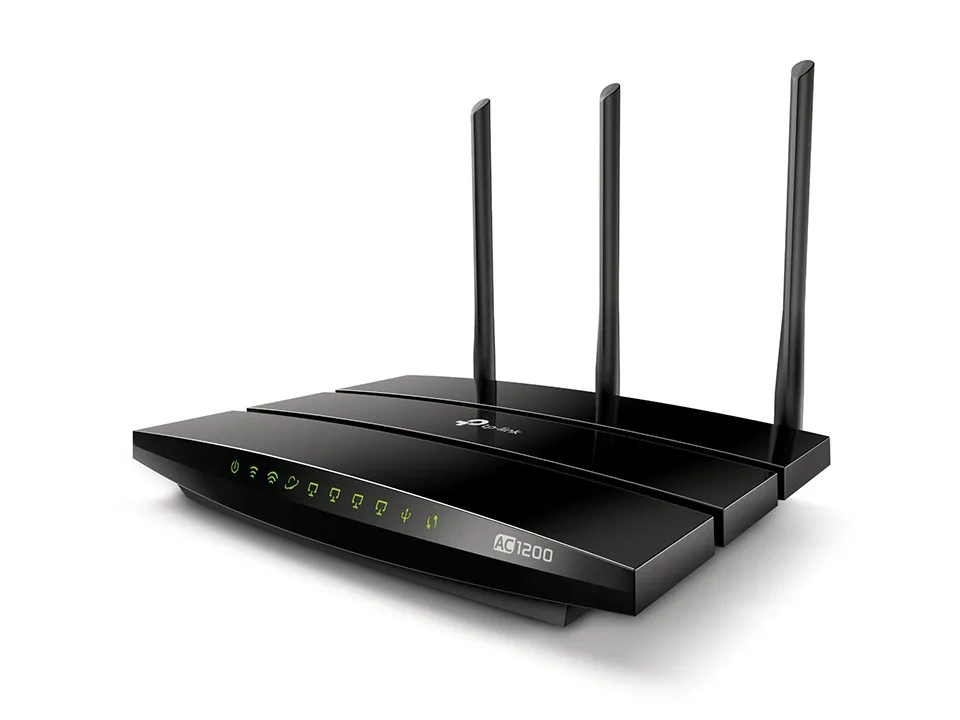
Common Questions
Do I need to be tech-savvy to use these routers?
Not really. Many brands like GL-iNet or TP-Link feature step-by-step wizards. Basic tasks—like scanning for a hotel Wi-Fi and entering a password—are straightforward. Advanced features like custom firewall rules or advanced VPN settings might require reading a bit of documentation, but everyday usage is quite approachable.
Will a travel router improve my existing hotel Wi-Fi speed?
It won’t exceed the hotel’s actual bandwidth, but it can better manage connections for your devices. Sometimes you’ll see improved reliability because the router’s antennas or channel strategies are more efficient. More importantly, it streamlines connecting multiple gadgets and secures data, which is its real superpower.
Can I just use my phone as a hotspot instead?
Yes, and many do. However, every device connecting to your phone can drain its battery faster. Also, some hotel networks or advanced setups are easier to handle with a dedicated router. If you’re hooking up a streaming stick and multiple laptops, or you want advanced VPN settings, a dedicated travel router is far more convenient.
How do I handle streaming sticks on hotel TVs?
Plug the stick into the TV’s HDMI, connect the stick to your travel router’s Wi-Fi network, and you’re good.
As far as the hotel is concerned, you only have one device online (the router). This bypasses casting blocks and captive portal issues, letting you watch content as if you were on your home network.
Is it safe to run a VPN from a travel router in certain countries?
Laws vary. Some regions block or restrict VPNs. Before traveling, check the local regulations. Many travelers do use them without incident, but it’s wise to confirm legalities to avoid issues.
Simple Steps for Initial Configuration
Even though each model has its own interface, the basic workflow tends to be consistent. Here’s a quick outline:
- Power the Router: If it’s USB Type-C, plug it into a laptop port, power bank, or your phone charger. Wait for lights or an SSID to appear.
- Connect a Device: Typically, you’ll see a default network name like “GL-MT300N-XYZ” or “AXT1800-ABC.” Enter the default Wi-Fi password from the underside label or manual.
- Change Credentials: After logging into the admin page (often 192.168.8.1 or something similar), set a new SSID and password for your own security. Also change the admin panel password from the default “admin.”
- Select WAN Source: If repeating hotel Wi-Fi, choose “Repeater” or “Wi-Fi as WAN,” then pick the hotel’s SSID. If using an Ethernet cable, plug it in and set the router’s WAN port. Tethering? Connect your phone via USB and enable hotspot mode.
- Optional: Import VPN Config: If you have a VPN subscription, upload or enter your credentials. Enable the VPN to protect your entire mini-network at once.
- Connect All Devices: Join your new SSID on your phone, laptop, streaming stick, etc. They’ll see each other locally, so casting or file sharing is easy. Meanwhile, the router manages the main connection for you.
In most cases, you’re fully set up in under 10 minutes. After you do it once, repeating the process on subsequent trips takes almost no time—particularly because the router may remember networks or your VPN details from the last usage.
Maintaining Your Router on the Go
Unlike a home router that sits in one spot for years, a travel router faces more challenges: constant plugging/unplugging, different power sources, random hotel policies, and so forth. Here’s how to keep it running optimally:
- Firmware Checks: Log in occasionally to see if the manufacturer pushed new updates. The difference in stability or device recognition can be significant with each patch.
- Clean Reboots: If you notice slow speeds or connectivity hiccups, power cycle your router. Something about traveling often leaves networks in weird states. A quick reboot is the easiest fix.
- Careful with Overheating: Some small routers run warm, especially in warm climates or stuffed in a bag. Let it breathe. If you’re in a very hot region, placing the router near an AC vent or in the shade helps maintain stable performance.
- Bring a Spare Cable or Two: If you rely on tethering or hooking to hotel Ethernet, losing that one short cable is a headache. A backup ensures you won’t be stuck without connectivity.
- Keep a Note of Admin Login: In case you factory reset the device or something goes wrong, have a saved note or photo of the default credentials. This can save panic in a hotel at midnight.
Treat your travel router well, and it’ll be a faithful ally in your quest for stable, secure connections anywhere.
Bonus: Introducing the GL.iNet Slate 7 (GL-BE3600)
For travelers wanting the absolute cutting edge, let’s highlight a brand-new model that’s pushing technology to the next level. The GL.iNet Slate 7 (GL-BE3600) debuts with Wi-Fi 7 capabilities—an evolution over Wi-Fi 6—offering even faster speeds and improved performance in congested networks.
Specifically, it supports up to 688 Mbps on 2.4GHz and 2882 Mbps on 5GHz, plus dual 2.5 Gbps WAN and LAN ports for ultra-fast wired transfers. It’s powered by a Qualcomm quad-core CPU at 1.1GHz, with 1GB of DDR4 RAM and 512MB of NAND Flash, giving it plenty of muscle for tasks like high-bit-rate streaming, heavy VPN encryption, or multi-link operation in crowded environments.
Inside, you’ll find advanced features like 30+ built-in VPN services, so you can choose your favorite provider for secure browsing. The device runs on OpenWrt for deep customization, plus it includes typical GL.iNet extras like AdGuard Home for network-wide ad-blocking. It’s still compact—measuring roughly 130 x 91 x 34 mm—and has foldable external Wi-Fi antennas.
Powering it via Type-C with PD support is straightforward, ensuring compatibility with popular 5V/3A, 9V/3A, or 12V/2.5A chargers. If you want the absolute latest standard, the Slate 7 might be your best bet for 2025 and beyond, especially if you demand blazing speeds for 4K streaming or want to connect a ton of devices at once.
The Slate 7 exemplifies next-gen wireless technology, addressing many “wish list” features travelers have sought: a secure router that’s small enough for carry-on convenience, but powerful enough to handle 100+ device connections or robust VPN usage in real time.
With refined OFDMA, preamble puncture, and Multi-Link Operation (MLO) from Wi-Fi 7, high-density environments (like big conventions) become more manageable. If you’re a forward-looking traveler or a tech enthusiast, the Slate 7 is a prime candidate to future-proof your portable setup.
Conclusion: Travel Router Bliss for 2025
Secure, convenient internet is no longer just a luxury; it’s practically a travel essential for many. Whether you’re streaming movies in a remote hotel, juggling numerous devices for your family, or running critical business tasks in another country, a travel router can make or break your trip’s productivity and enjoyment.
By keeping all your gadgets behind a single, private network, you eliminate those repeated captive portal logins and drastically reduce the risk of hacking on public hotspots.
In 2025, we see a wide range of routers that fit different budgets and needs. Affordable single-band devices still get the job done for travelers with minimal internet demands, while new Wi-Fi 7 powerhouses like the GL.iNet Slate 7 redefine what’s possible on the go.
If you’re intrigued by the advanced features—like multi-WAN failover, fast VPN encryption, or local file sharing—opting for a dual-band or Wi-Fi 6/7 router might be worth the extra cost. Meanwhile, budget picks like the Mango prove you don’t need to spend big to unify your devices behind a consistent, secure network.
After traveling with a dedicated portable router, it’s hard to go back. Casting Netflix to the hotel TV, automatically reconnecting your phone, laptop, and tablet wherever you land, and toggling a VPN with one click become routine. A travel router is the kind of device that, once you’ve tried it, you’ll wish you had discovered sooner.
Here’s hoping the insights in this post help you pick the perfect one for your adventures, whether you choose a dependable Wi-Fi 6 mainstay or gear up for the next wave with Wi-Fi 7 and the new Slate 7. Safe travels and smooth surfing, wherever the road takes you.


